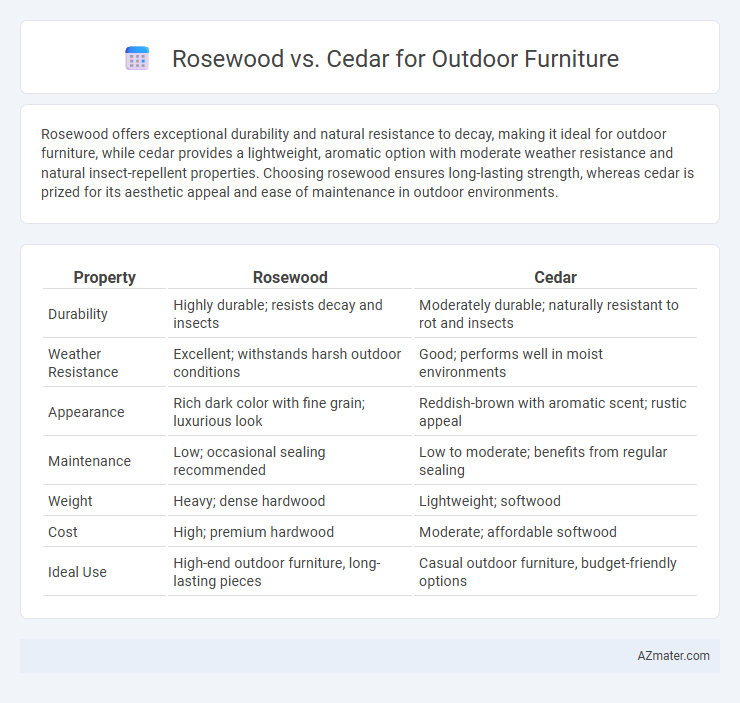Rosewood offers exceptional durability and natural resistance to decay, making it ideal for outdoor furniture, while cedar provides a lightweight, aromatic option with moderate weather resistance and natural insect-repellent properties. Choosing rosewood ensures long-lasting strength, whereas cedar is prized for its aesthetic appeal and ease of maintenance in outdoor environments.
Table of Comparison
| Property | Rosewood | Cedar |
|---|---|---|
| Durability | Highly durable; resists decay and insects | Moderately durable; naturally resistant to rot and insects |
| Weather Resistance | Excellent; withstands harsh outdoor conditions | Good; performs well in moist environments |
| Appearance | Rich dark color with fine grain; luxurious look | Reddish-brown with aromatic scent; rustic appeal |
| Maintenance | Low; occasional sealing recommended | Low to moderate; benefits from regular sealing |
| Weight | Heavy; dense hardwood | Lightweight; softwood |
| Cost | High; premium hardwood | Moderate; affordable softwood |
| Ideal Use | High-end outdoor furniture, long-lasting pieces | Casual outdoor furniture, budget-friendly options |
Introduction to Rosewood and Cedar as Outdoor Furniture Materials
Rosewood and cedar are popular choices for outdoor furniture due to their durability and aesthetic appeal. Rosewood, known for its rich color and dense grain, offers exceptional resistance to decay and insect damage, making it ideal for long-lasting outdoor pieces. Cedar features natural oils that protect against moisture and pests while providing a lightweight, weather-resistant option favored for its aromatic scent and classic reddish-brown hue.
Visual Appeal: Comparing the Looks of Rosewood and Cedar
Rosewood features a rich, deep reddish-brown color with striking dark veining, giving outdoor furniture an elegant, luxurious appearance. Cedar offers a lighter, warm reddish tone with a natural, rustic charm that weathers gracefully over time. The distinct grain patterns and color intensities of rosewood create a more formal aesthetic, while cedar's softer palette suits casual, cozy outdoor settings.
Durability and Longevity in Outdoor Conditions
Rosewood exhibits exceptional durability and resistance to decay, making it ideal for outdoor furniture exposed to harsh weather. Cedar offers natural resistance to moisture and insects but is softer and may require more maintenance over time. Rosewood's dense grain and high oil content ensure superior longevity compared to cedar's moderate durability in outdoor conditions.
Weather Resistance: Performance in Various Climates
Rosewood offers excellent weather resistance due to its dense grain and natural oils, making it highly durable in humid and rainy climates without warping or cracking. Cedar contains natural preservatives that protect against moisture, decay, and insect damage, performing well in wet and coastal environments. Both woods resist weather effects effectively, but rosewood excels in extreme humidity, while cedar adapts better to fluctuating temperatures and UV exposure.
Maintenance Requirements and Care Tips
Rosewood outdoor furniture demands regular oiling and cleaning to maintain its natural luster and prevent cracking, thriving with minimal exposure to moisture, while cedar requires periodic sealing and occasional sanding to combat weathering and preserve its aromatic qualities. Both woods benefit from protective covers during harsh weather to extend longevity and reduce the need for intensive maintenance. Proper care ensures that rosewood remains richly polished and cedar retains its distinctive scent and resistance to decay over time.
Cost Comparison: Rosewood vs Cedar Outdoor Furniture
Rosewood outdoor furniture typically costs significantly more than cedar due to its dense grain, durability, and exotic appeal, with prices often ranging from $150 to $300 per piece compared to cedar's $100 to $200 range. Cedar offers a more budget-friendly option while still providing natural resistance to decay and insects, making it a cost-effective choice for outdoor use. The higher upfront investment in rosewood is balanced by its longer lifespan and lower maintenance requirements, potentially reducing long-term replacement and upkeep expenses.
Environmental Impact and Sustainability Factors
Rosewood, often sourced from tropical hardwood forests, faces significant environmental challenges due to overharvesting and slow regeneration, leading to concerns over deforestation and habitat loss. Cedar, particularly Western Red Cedar, is widely regarded as a sustainable choice for outdoor furniture because it is faster-growing, commonly harvested from managed forests, and naturally resistant to decay without chemical treatments. Choosing cedar over rosewood minimizes ecological footprint while supporting sustainable forestry practices and reducing impact on biodiversity.
Weight and Workability of Rosewood vs Cedar
Rosewood is significantly denser and heavier than cedar, making it more durable but less portable for outdoor furniture. Cedar's lightweight nature enhances its workability, allowing for easier cutting, shaping, and installation compared to the hard, dense fibers of rosewood. The high density of rosewood provides greater resistance to wear and weathering, while cedar offers improved machinability and faster project completion.
Comfort and Practicality for Outdoor Use
Rosewood offers exceptional durability and natural resistance to weather elements, making it a practical choice for outdoor furniture while providing a smooth, comfortable finish that ages well with minimal maintenance. Cedar is lightweight and naturally resistant to decay and insect damage, enhancing outdoor comfort through its ability to stay cool under direct sunlight and maintain a pleasant aroma. Both woods balance comfort and practicality, but rosewood's density provides greater longevity and a richer feel, whereas cedar excels in breathability and ease of handling for outdoor settings.
Choosing the Best Wood: Which is Right for Your Outdoor Space?
Rosewood offers exceptional durability and a rich, dark grain that resists moisture and insects, making it ideal for long-lasting outdoor furniture in humid climates. Cedar is lightweight, naturally aromatic, and contains oils that prevent rot and repel pests, providing a more budget-friendly option with a warm, reddish hue suited for moderate weather conditions. Choosing between rosewood and cedar depends on climate resilience, maintenance preferences, and desired aesthetic, with rosewood excelling in durability and cedar offering natural resistance and ease of handling.

Infographic: Rosewood vs Cedar for Outdoor Furniture
 azmater.com
azmater.com